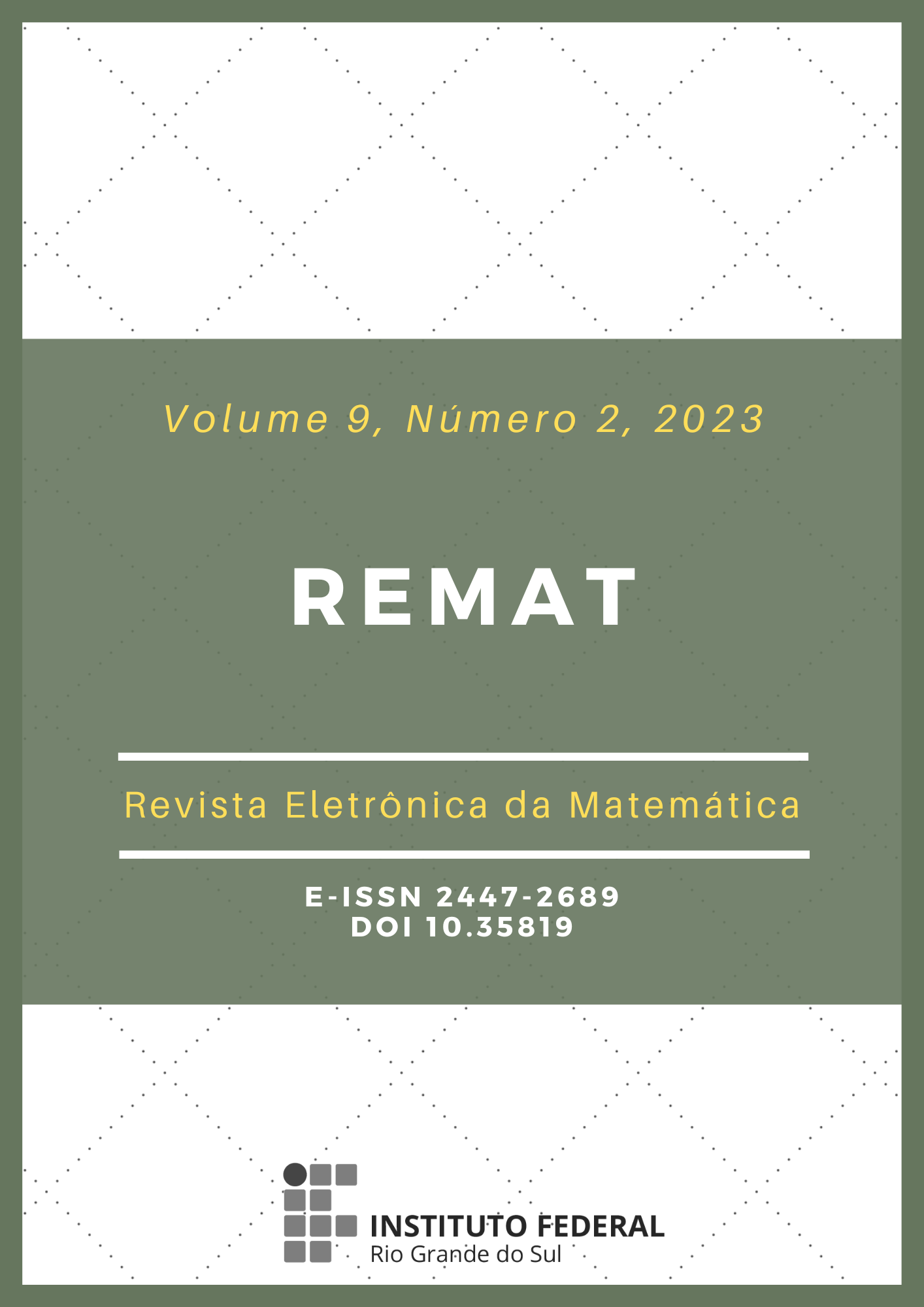Study of numbers whose sum of digits is equal to 9 via linear diophantine equations
DOI:
https://doi.org/10.35819/remat2023v9i2id6679Keywords:
table of 9, linear diophantine equations, multiples of 9, mathematical modeling, number theoryAbstract
A classic property of the 9 times table is that the results of multiplying 1 to 10 by 9 are, in addition to 9, two-digit numbers, xy, such that x+y=9. This work has as main objective to use the idea of this property for the study of analogous conditions for natural numbers of three and four digits. For this, linear Diophantine equations of two, three and four variables and their resolution techniques were used. As a result, it was determined which and how many are the natural numbers of two, three and four digits whose sum of digits are equal to 9. It was also verified that the number of numbers whose sum of digits is equal to 9, in the ranges from 1 to 999, from 1000 to 1999, from 2000 to 2999, and so on until the range of 9000 to 9999 obeys the descending sequence of the first 10 triangular numbers.
Downloads
References
BERNSTEIN, Leon. The linear Diophantine equation in variables and its application to generalized Fibonacci numbers. The Fibonacci Quarterly, v. 6, n. 3, p. 1-63, 1968. Disponível em: https://www.fq.math.ca/Scanned/6-3/bernstein.pdf. Acesso em: 5 dez. 2023.
COBB, Stacy; PATTERSON, Natasha; LEMMA, Mulatu. The fascinating mathematical beauty of triangular numbers. Georgia Journal of Science, v. 66, n. 2, article 9, p. 158-168, 2008. Disponível em: https://digitalcommons.gaacademy.org/gjs/vol66/iss2/9. Acesso em: 5 dez. 2023.
DARIO, Ronie Peterson. Equações diofantinas e alocação otimizada de recursos financeiros de pequenos investidores no mercado acionário brasileiro. REMAT: Revista Eletrônica de Matemática, Bento Gonçalves, RS, v. 8, n. 1, p. e3007, jun. 2022. DOI: https://doi.org/10.35819/remat2022v8i1id5674.
FOMÍN, Serguei Vasil'evich. Sistemas de numeración. Lecciones Populares de Matemáticas. Trad.: Carlos Vega. Moscú, Spanish: Editorial MIR, 1975.
HEFEZ, Abramo. Aritmética. Rio de Janeiro, RJ: Sociedade Brasileira de Matemática, 2016.
IZMIRLI, Ilhan M. On some properties of digital roots. Advances in Pure Mathematics. v. 4, n. 6, p. 295-301, 2014. DOI: https://doi.org/10.4236/apm.2014.46039.
MAN, Yiu-Kwong. A forward approach for solving linear Diophantine equation. Journal of Mathematical Education in Science and Technology. v. 51, n. 8, p. 1284-1288, 2020. DOI: https://doi.org/10.1080/0020739X.2020.1745915.
NASCIMENTO, Érick Caetano Alves do; SILVA FILHO, Marcos Miguel da; TANAKA, Thiago Yukio; ARAÚJO, Jogli Gidel da Silva. Do termo geral à soma de Gauss: uma abordagem olímpica sobre progressões aritméticas. REMAT: Revista Eletrônica de Matemática, Bento Gonçalves, RS, v. 9, n. 1, p. e3001, jan. 2023. DOI: https://doi.org/10.35819/remat2023v9i1id5727.
OBMEP. Clubes de Matemática da OBMEP: Disseminando o estudo da Matemática. Números triangulares. Disponível em: http://clubes.obmep.org.br/blog/sala-de-leitura-numeros-triangulares/. Acesso em: 3 mar. 2023.
REIS, Ana Clara dos Santos; SOUZA, Caroline Helena Costa; DOMINGUES, José Sérgio. Modelagem matemática para uma propriedade aritmética da tabuada de multiplicação do 9. In: SEMINÁRIO DE PESQUISA E INOVAÇÃO, 5., 2022, Formiga. Anais [...]. Formiga: IFMG, textit{Campus Formiga, 2022. Disponível em: https://www.formiga.ifmg.edu.br/documents/2022/Seminarios%202022/6%20-%20Modelagem%20matematica.pdf. Acesso em: 5 dez. 2023.
RICHIT, Luiz Augusto; RICHIT, Adriana; RICHIT, Andriceli. Solução particular de equações diofantinas lineares $ax+by=c$ via abordagem por substituição progressiva do algoritmo de Euclides. Revista Sergipana de Matemática e Educação Matemática, Itabaiana, SE, v. 6, n. 3, p. 97-122, 2021. Disponível em: https://periodicos.ufs.br/ReviSe/article/view/15046. Acesso em: 5 dez. 2023.
RODRIGUES, Flávio Wagner. A prova dos nove: como e por que funciona (ao menos quase sempre). Revista do Professor de Matemática, n. 14, p. 17-20, 1989. Disponível em: https://rpm.org.br/cdrpm/14/3.htm. Acesso em: 5 dez. 2023.
SANTOS, José Plínio de Oliveira. Introdução à Teoria dos Números. 3. ed. Rio de Janeiro: IMPA, 2020.
SOUZA, Romario Sidrone de. Equações diofantinas lineares, quadráticas e aplicações. Orientadora: Carina Alves. 2017. 75 f. Dissertação (Mestrado em Matemática) - Instituto de Geociências e Ciências Exatas, Universidade Estadual Paulista, Rio Claro, São Paulo, 2017. Disponível em: https://igce.rc.unesp.br/Home/Pos-Graduacao44/programasdepos/souza_rs_me_rcla.pdf. Acesso em: 5 dez. 2023.
VYAWAHARE, Anant. The digital root. At Right Angles, v. 5, n. 2, p. 42-44, 2016. Disponível em: https://publications.azimpremjiuniversity.edu.in/1435/1/08-The Digital Root.pdf. Acesso em: 5 dez. 2023.
Downloads
Published
Issue
Section
License
Copyright (c) 2023 REMAT: Revista Eletrônica da Matemática

This work is licensed under a Creative Commons Attribution 4.0 International License.
REMAT retains the copyright of published articles, having the right to first publication of the work, mention of first publication in the journal in other published media and distribution of parts or of the work as a whole in order to promote the magazine.
This is an open access journal, which means that all content is available free of charge, at no cost to the user or his institution. Users are permitted to read, download, copy, distribute, print, search or link the full texts of the articles, or use them for any other legal purpose, without requesting prior permission from the magazine or the author. This statement is in accordance with the BOAI definition of open access.













 https://orcid.org/0000-0002-0893-7426
https://orcid.org/0000-0002-0893-7426


















